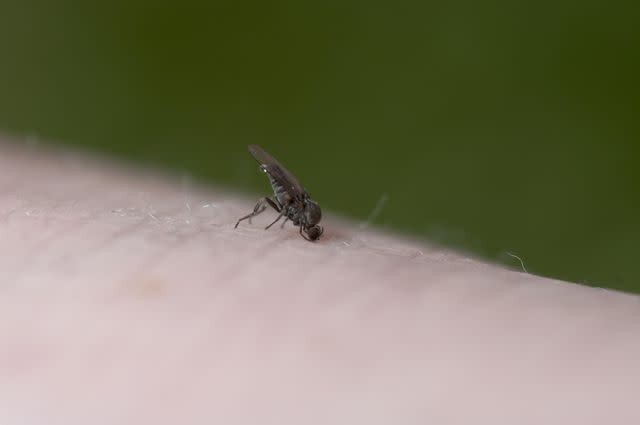CDC: Leishmaniasis May Be Endemic in Texas, Oklahoma
Fact checked by Nick Blackmer
New data from the Centers for Disease Control and Prevention (CDC) show that leishmaniasis may be endemic in the U.S.
The skin condition is spread by the bite of infected sandflies.
Experts recommend precautions like bug spray and long sleeves if you live in an area that has sandflies.
Health authorities are maintaining careful observation of a potentially disfiguring skin disease that has been identified in the U.S.
More than 1,200 cases of leishmaniasis, which is usually found in tropical and subtropical areas outside the country and causes skin sores, were identified by the Centers for Disease Control and Prevention (CDC) between 2005 and 2019, according to data presented at the Annual Meeting of the American Society of Tropical Medicine and Hygiene in Chicago.
There are several forms of leishmaniasis, including cutaneous leishmaniasis, which causes skin sores, and visceral leishmaniasis, which impacts several internal organs.
Cutaneous leishmaniasis is the type that’s been detected in the U.S., Mary Kamb, MD, MPH, a medical epidemiologist at the Division of Parasitic Diseases and Malaria at the CDC, told Health.
Symptoms of Leishmaniasis
Symptoms of cutaneous leishmaniasis depend on where the lesions are located and can include:
Breathing difficulty
Skin sores, which can become a skin ulcer that heals very slowly
Stuffy nose
Runny nose
Nosebleeds
Swallowing difficulty
Ulcers and wearing away in the mouth, tongue, gums, lips, nose, and inner nose
Leishmaniasis is spread by the bite of infected female phlebotomine sand flies. The sand flies become infected by sucking blood from an infected animal or person.
“The sandflies are very tiny,” leishmaniasis researcher Naomi E. Aronson, MD, director of the Infectious Diseases Division at Uniformed Services University of the Health Sciences, told Health. “They’re what we call ‘no-see-ums.’”
Some types of Leishmania parasites can be spread through contaminated needles, blood transfusion, or from a pregnant woman to her baby, but the biggest concern in the U.S. is infected sandflies.
Here’s what you need to know about leishmaniasis in the United States, and how you can lower your risk of infection.

Getty Images / Jill Ferry Photography
Related: What Are Parasites?
Is Leishmaniasis Spreading in the US?
While the CDC study found more than 1,200 cases of leishmaniasis in the U.S., not everyone was infected while in the country.
“Most people who tested positive had a history of international travel, often to Latin America,” Kamb said.
That said, some cases were from people who hadn’t traveled outside the United States.
“There are an increasing number of case reports of cutaneous leishmaniasis [that] has been in people living in Texas who had never traveled outside the United States,” Kamb clarified.
To date, most confirmed cases have been reported from Texas and at least one has been reported from Oklahoma, she explained.
The particular sandfly species that seems to be responsible for the U.S. cases of leishmaniasis—L. mexicana—“may be endemic in some parts of the United States, particularly Texas,” Kamb said.
Meaning, it lives in the area and may be spreading leishmaniasis as a result.
Since the sandfly exists in other areas outside of Texas, spreading could potentially be a larger problem.
“The sandfly can be seen as far north as Ohio, so there may be other cutaneous cases that exist that were misdiagnosed,” Amesh A. Adalja, MD, infectious disease expert and senior scholar at the Johns Hopkins Center for Health Security, told Health.
Lowering Your Risk of Leishmaniasis
Lowering your risk of leishmaniasis starts with being aware of sandflies in your area.
Sandflies are most active in the evening and at nighttime, making it important to be aware that there is a risk of being bitten and possibly infected if you live in Texas and surrounding areas, Russo said.
It’s also a good idea to wear long sleeves and pants if you’re in more rural areas where there are sandflies, Aronson added.
“The sandfly has very small mouthparts and can’t bite through clothing well,” she explained.
You can also use bug spray with DEET on areas of exposed skin. And, while sandflies can travel through bug nets, they don’t fly very well, Aronson explained.
“Having air conditioning and a fan on can create enough turbulence that the fly has difficulty landing on people,” she said.
If you develop a sore and aren’t sure what’s behind it, or if you have other symptoms of leishmaniasis, it’s a good idea to see your dermatologist, Thomas Russo, MD, a professor and chief of infectious diseases at the University at Buffalo in New York, told Health.
“The parasite can be identified through a biopsy,” he said.
After a biopsy, you’ll likely be referred to an infectious disease physician for treatment, which involves medications such as Ambisome (amphotericin b) or Impavido (miltefosine).
While cutaneous leishmaniasis usually heals on its own, it can take months for sores to go away if left untreated.
Both healthcare providers and patients must understand the reality of leishmaniasis in the United States so quick actions can be taken if treatment is necessary.
Related: CDC Alert: First Locally-Acquired Malaria Cases Reported in the US in 20 Years
For more Health.com news, make sure to sign up for our newsletter!
Read the original article on Health.com.

